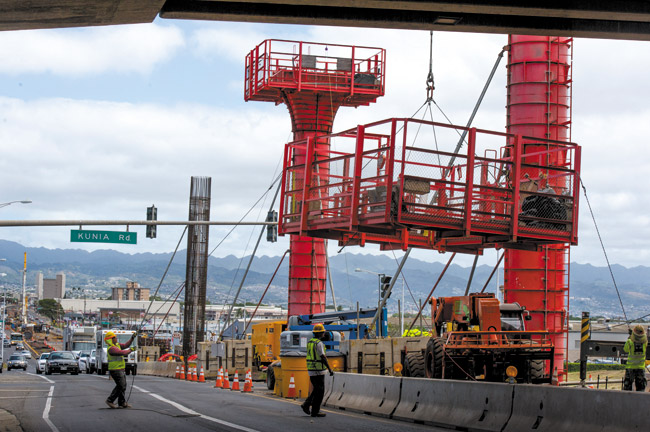The Mayor Of Punchbowl Street

WDA Workers place a platform on top of a railway column near the intersection of Kunia Road and Farrington Highway
CRAIG T. KOJIMA / STAR-ADVERTISER PHOTO
Kirk Caldwell recently passed the midpoint of his first term as mayor of the City and County of Honolulu. He won his post in November 2012, running as a proponent of a fixed-rail mass-transit system. His opponent, former Gov. Ben Cayetano, ran against it.
Subsequently, lawsuits initiated by Cayetano and others to stop rail were rejected. Construction began, and rail’s elevated guideways are snaking across the Ewa Plain to the edge of Waipahu. Kiewit’s yellow trucks and cranes now can be seen in Waipahu town and Pearl City.
So rail is a done deal. Mayor Caldwell can turn his attention to other things. Right?
Hardly. Recently reported cost overruns of between $700 million and $900 million have reignited the debate over rail.
“We’re having re-debate of rail,” says Caldwell, “and people have a right to it. My job is to address their questions and get all the information out there. Rail is a huge challenge, one I have to meet.”
In his 2015 State of the City address, Caldwell attributed the overruns to “delays in accepting the final environmental impact statement” and by “delays caused by lawsuits.” Together they “pushed us into the hottest construction market in the United States. Our climb in construction costs is faster than New York City or L.A., the two other very hot markets.”
He also opposed raising property taxes or abandoning construction. He characterized the latter as “crazy … We sit in gridlock every day. We made a promise to the folks on the West side … under the general growth plan in the 1970s. We said, 70 percent of all the growth on this island will occur in the Ewa plain. Then we doomed them to one freeway, with no other choices.
“Rail is about giving people a choice to get out of their cars and travel quickly and efficiently to and from Kapolei, the Ewa plain, into town and back.”
In order to pay for the overruns, Caldwell favors extending the half-percent excise tax: “Why do I like that choice? Because our visitors pay one-third of that tax.”
So Caldwell has trudged a well-worn path between Honolulu Hale and the state Capitol for the past few months. He’s been crossing Punchbowl Street on a near daily basis, at times to testify, at other times to lobby: “I’ve talked to the governor, to the lieutenant governor and to members of the Legislature. There are 76 of them. I’m down to the last 15. I testified and took questions for two-and-a-half hours before the House Finance Committee. I’m at it full time every day.”
At midpoint in the session, both legislative branches had passed bills extending the excise tax for rail — the Senate a half percent until 2022, the House a quarter percent indefinitely. Caldwell prefers the Senate version, but will take what he can get.
Caldwell rejects the notion that Honolulu’s drivers won’t get out of their cars and onto the train: “Of course they will. In every other city that has a transit system, people ride it.”
He knows that his travails over the rail issue won’t end soon.
“Charlotte, N.C., recently completed a transit system,” he says. “Charlotte’s mayor warned me never to let my guard down. When one opposition to rail dies down, another always arises.”
dbboylan70@gmail.com





